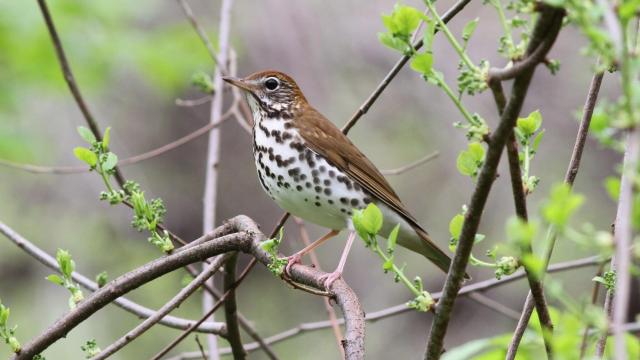There are almost 3 billion fewer North American birds in 2019 than there were in 1970, accounting for a 29 per cent decline, according to a new study.
It’s clear that humans have done a number on the environment, since the climate is warming and species are going extinct at an alarming rate. But birds in particular are a useful indicator for monitoring environmental health overall and are better-monitored than most animals thanks to large citizen science databases and radar data, according to the paper published Friday in Science. The large decline in the overall number of birds demonstrates that Americans urgently need to address their behaviour.
“The birds are the canary in the coal mine,” Arvind Panjabi, one of the study’s authors from The Bird Conservancy of the Rockies, told Gizmodo. “When the birds are dying, it surely can’t be good for us either.”
The calculations account for 529 species of birds in the United States and Canada, 76 per cent of the birds that breed here. The researchers used 48 years of data from standardised bird-monitoring databases, such as the National Audubon Society’s 120-year-running Christmas Bird Count.
They corroborated this data with data taken from a network of 143 weather radars in the United States from 2007 to 2017; migrating birds show up on weather radars, from which scientists can calculate the overall change in avian biomass. The estimates are conservative, the authors write in the paper.
The independent datasets agreed: The birds are dying. The surveys demonstrated that of the 529 species, 57 per cent are in decline, including many common birds such as horned larks and even introduced species like feral city pigeons and house sparrows. Grassland and forest birds took the hardest hits. The only biome that hasn’t lost overall numbers is wetlands.
It’s a dire situation. “At first we thought it was just aerial insectivores and grassland birds,” Nicole Michel, a senior quantitative ecologist at the National Audubon Society who was not involved in the study, told Gizmodo. “But if even the most common birds are experiencing substantial declines, it suggests that we have a lot of work to do. When you have so many different birds in different areas with different foods and habitats they use, there’s not just one problem. There are lots of things we have to fix.”
Various causes are contributing to the decline, but among the most important are habitat being converted for agricultural use and urbanisation — as well as pesticides. Just last week, a study showed that the common and controversial neonicotinoid pesticides caused migrating birds to lose weight, and declines in insect biodiversity affect the birds that eat those insects. But there are other causes.
Outdoor and feral cats kill between 1.3 billion and 4 billion birds in the United States annually, while commonly cited statistics suggest that hundreds of millions of birds die every year in collisions with windows.
Based on those estimates, wind turbines, often vilified for their effects on birds by those opposed to moving away from fossil fuels, account for just a small percentage of annual bird deaths.
Meanwhile, the Trump administration has taken steps to weaken the Migratory Bird Treaty Act (MBTA), the 101-year-old law that forbids killing or owning any part of a native migrating bird species. And birds might be the tip of the iceberg, the authors write.
If birds are suffering, surely other groups of animals are suffering, too. The issue is not limited to the United States, as many of these birds migrate to Central and South America, where they face threats at their wintering grounds as well. Who knows? Eventually, we might be the ones going extinct.
This is something everyone should care about. A U.S. Fish and Wildlife Services report found that more than 100 million Americans, 40 per cent of Americans older than 16, engage in wildlife-dependent activities, including a substantial increase in wildlife watchers and fishers, despite a decrease in hunters.
But there is reason to hope, so long as people act. Panjabi explained that MBTA led to a rebound in birds harvested for their feathers like herons and egrets, and 1970s laws limiting the use of DDT brought back peregrine falcons and bald eagles. Wetland birds might be the only group of birds increasing thanks in part to the North American Wetland Conservation Act that protects their habitats.
A bipartisan bill in Congress called the Recovering America’s Wildlife Act will hopefully earmark more than a billion dollars annually for habitat restoration and implementing new conservation programs. Michel told Gizmodo that Audubon conservationists also hope to target protections for the Arctic, revitalize the Great Lakes and the Everglades, and further strengthen the MBTA, among other goals.
There are simple things anyone can do, Sara Hallager, curator of birds at the Smithsonian National Zoo, told Gizmodo. Keep your cats indoors (or build outdoor enclosures for them); install bird-safe windows or simply put stickers on them to prevent bird collisions; and drink bird-friendly coffee. And of course, use your votes to elect politicians who care about the long-term health of the country, the land that it’s built on, and the humans and animals that live here.
The situation is dire and will take coordinated, international efforts to fix. But scientists hope that the study will be a turning point that mobilises people into caring.
“History has shown time and time again that when we act, we can make a difference,” Panjabi said. “We can’t despair. We have to take action.”
